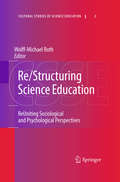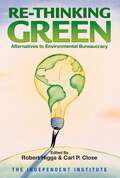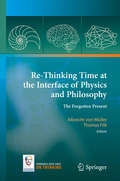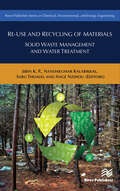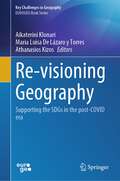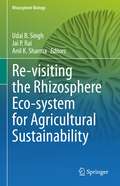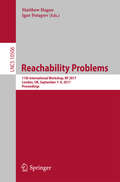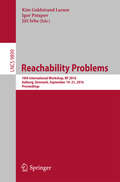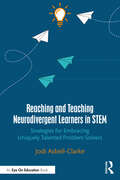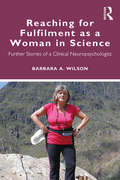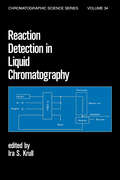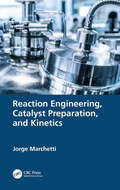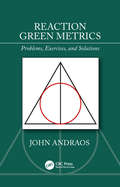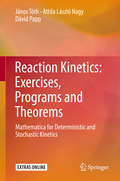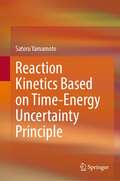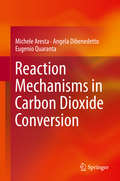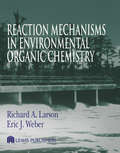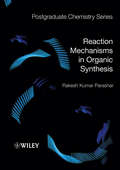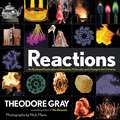- Table View
- List View
Re/Structuring Science Education
by Wolff-Michael RothSince its beginnings, science education has been under the influence of psychological theories of knowing and learning, while in more recent years, social constructivist and sociological frameworks have also begun to emerge. With little work being done on showing how the perspectives of these separate approaches might be integrated, this work aims to plug the gap. The book helps lay the groundwork for reuniting sociological and psychological perspectives on the knowing, learning, and teaching of science. Featuring a range of integrative efforts beginning with simple conversation, the chapters here include not only articles but also commentaries that engage with other papers, as well as a useful running narrative that, from the introduction to the epilogue, contextualizes the book and its sections. Specific attention is given to cultural-historical activity theory, which already offers an integration of psychological and cultural-historical (sociological) perspectives on collectively motivated human activities. A number of chapters, as well as the contextualizing narrative, explicitly use this theory as a framework for rethinking science education to achieve the reunification that is the goal of this work. All the contributors to this volume have produced texts that contribute to the effort of overcoming the extant divide between sociological and psychological approaches to science education research and practice. From very different positions--gender, culture, race--they provide valuable insights to reuniting approaches in both theory and method in the field. As an ensemble, the contributions constitute a rich menu of ideas from which new forms of science education can emerge.
Re-Thinking Green: Alternatives to Environmental Bureaucracy
by Robert HiggsEnvironmental quality has been a major public concern since the first Earth Day in 1970, yet the maze of environmental laws and regulations enacted since then has fostered huge government bureaucracies better known for waste and failure than for innovation and success.Can we do better than this failed environmental bureaucracy? The noted contributors to this volume answer with a resounding "yes." Re-Thinking Green exposes the myths that have contributed to failed environmental policies and proposes bold alternatives that recognize the power of incentives and the limitations of political and regulatory processes. It addresses some of the most hotly debated environmental issues and shows how entrepreneurship and property rights can be utilized to promote environmental quality and economic growth. Re-Thinking Green will challenge readers with new paradigms for resolving environmental problems, stimulate discussion on how best to "humanize" environmental policy, and inspire policymakers to seek effective alternatives to environmental bureaucracy.
Re-Thinking Time at the Interface of Physics and Philosophy
by Albrecht Müller Thomas FilkThe current volume of the Parmenides Series "On Thinking" addresses our deepest and most personal experience of the world, the experience of "the present," from a modern perspective combining physics and philosophy. Many prominent researchers have contributed articles to the volume, in which they present models and express their opinions on and, in some cases, also their skepticism about the subject and how it may be (or may not be) addressed, as well as which aspects they consider most relevant in this context. While Einstein might have once hoped that "the present" would find its place in the theory of general relativity, in a later discussion with Carnap he expressed his disappointment that he was never able to achieve this goal. This collection of articles provides a unique overview of different modern approaches, representing not only a valuable summary for experts, but also a nearly inexhaustible source of profound and novel ideas for those who are simply interested in this question.
Re-Use and Recycling of Materials: Solid Waste Management and Water Treatment (River Publishers Series In Chemical, Environmental, And Energy Engineering Ser.)
by Jibin K. P. Nandakumar Kalarikkal Sabu Thomas Ange NzihouIn recent years, a considerable amount of effort has been devoted, both in industry and academia, towards the recycling and reuse of materials. Most nations are now trying to reduce the amount of waste materials, through the proper recycling of materials.Re-Use and Recycling of Materials will help readers to understand the current status in the field of waste management, as well as what research is taking place to deal with such issues.Technical topics discussed in the book include: Municipal solid waste management Recycling of WEEE Waste to industrially important product like lignin and cellulose Recycling of agriculture waste Polymer and plastic recycling
Re-visioning Geography: Supporting the SDGs in the post-COVID era (Key Challenges in Geography)
by Aikaterini Klonari Maria Luisa De Lázaro y Torres Athanasios KizosGeography is a discipline with a profound interdisciplinary character focusing on studying the complex interactions between nature and society. Geography can advance the level of knowledge and awareness and provide important contributions to support the achievement of Sustainable Development Goals. This book explores some of these issues, while also disseminating and supporting the efforts of geographers worldwide to promote the implementation of the SDGs. It offers local and global perspectives to a variety of topics covered by the SDGs, such as: How do different actors such as universities, companies and education actors respond to Sustainable Development Goals, especially during the complex context of the COVID pandemic? What is the role of novel spatial technologies and open/big data in achieving SDGs and how can Geography assist? How are new eco-social challenges positioned in a post-pandemic global change? What are novel educational contexts and resources that can be used to transform society toward sustainability of socioecological systems? What conceptual frameworks and strategies can contribute to the construction of societies based on human welfare and the care of nature? This book is focused on innovative sustainability-oriented geographical research on the above (and more) topics that explore the diverse social, environmental, economic and cultural contexts at various spatial scales. It also includes chapters that report on geographical education initiatives in schools and universities, the implication of geographers in community-based learning and increasing community's awareness in terms of environment, climate change and sustainable development as well as chapters that make use of geospatial technologies (e.g., remote sensing, GIS, etc.) both in geographical research and education for sustainable development are particularly relevant for the book.
Re-visiting the Rhizosphere Eco-system for Agricultural Sustainability (Rhizosphere Biology)
by Udai B. Singh Jai P. Rai Anil K. SharmaThe present book entitled, “Re-visiting the Rhizosphere Eco-system for Agricultural Sustainability” written by experts in the field, provides a comprehensive and consolidated state-of art overview of various aspects of rhizosphere biology, ecology and functioning. The role of rhizosphere microbial diversity in enhancing plant health and plant-microbe beneficial symbioses is discussed. Main topics include the diversity of plant-associated microbes in the rhizosphere, below-ground communication among the plant, soil, insects and microbes, rhizosphere ecosystem functioning, rhizosphere engineering, recruitment of microorganisms in the rhizosphere, mycorrhizal fungal symbiosis, positive interaction of the plants with the beneficial soil microorganisms for inducing the plant growth, conferring abiotic and biotic stress tolerance and modulating several pathways of the plants for the proper establishment and revitalization in the degraded and contaminated soils or negative likes the host-pathogen interactions leading to the disease development in plants. Further chapters focus on the role of signaling during the different stages of the plant-microbe coexistence, in symbiotic or pathogenic relationships, in quorum sensing, microbial signaling and cross-talk, bio-film formation, and antimicrobial peptides. The book also discusses the application of microbes in biodegradation of xenobiotic contaminants, bioremediation of heavy metals, sustainable agriculture and soil health, biological control of insect pests and plant pathogens, and the latest tools of omics which offer pioneering approaches to the exploration of microbial structure and function, secretome, holobiome, below-ground interaction, and microbial cooperation for sustainable food production and enhanced resource acquisition. Descriptions of cutting-edge techniques and novel approaches make this book unique in the area of rhizosphere biology. This is a useful reading material for researchers and students of microbiology, agriculture, ecology, and rhizosphser studies.
Reachability Problems
by Matthew Hague Igor PotapovThis book constitutes the refereed proceedings of the 11th International Workshop on Reachability Problems, RP 2017, held in London, UK, in September 2017. The 12 full papers presented together with 1 invited paper were carefully reviewed and selected from 17 submissions. The aim of the conference is to bring together scholars from diverse fields with a shared interest in reachability problems, and to promote the exploration of new approaches for the modelling and analysis of computational processes by combining mathematical, algorithmic, and computational techniques. Topics of interest include (but are not limited to): reachability for innite state systems; rewriting systems; reachability analysis in counter/timed/cellular/communicating automata; Petri nets; computational aspects of semigroups, groups, and rings; reachability in dynamical and hybrid systems; frontiers between decidable and undecidable reachability problems; complexity and decidability aspects; predictability in iterative maps, and new computational paradigms.
Reachability Problems
by Kim Guldstrand Larsen Igor Potapov Jiří SrbaThis book constitutes the proceedings of the 8th International Workshop on Reachability Problems, RP 2014, held in Oxford, UK, in September 2014. The 17 papers presented in this volume were carefully reviewed and selected from 25 submissions. The book also contains a paper summarizing the invited talk. The papers offer new approaches for the modelling and analysis of computational processes by combining mathematical, algorithmic, and computational techniques.
Reaching and Teaching Neurodivergent Learners in STEM: Strategies for Embracing Uniquely Talented Problem Solvers
by Jodi Asbell-ClarkeProviding salient stories and practical strategies, this book empowers educators to embrace the unique talents of neurodivergent learners in science, technology, engineering, and mathematics (STEM). An exploration of the exciting opportunities neurodiversity presents to build an innovative workforce is grounded in a large body of research from psychology, neuroscience, and education. Author Jodi Asbell-Clarke presents individual examples of neurodivergent journeys in STEM to establish evidence-based connections between neurodiversity and the types of innovative problem-solving skills needed in today’s workforce. The featured stories come directly from the author’s many years in inclusive classrooms with STEM teachers along with interviews from many neurodivergent professionals in STEM. Teachers will learn how to embrace the unique brilliance and potential of the neurodivergent learners in their classroom, working against historic marginalization and deficit-based perspectives of neurodiversity within the education system. Featuring illustrations of classroom-designed tools and materials alongside basic strategies to support executive function and emotion in learning, this book will help you nurture the talents of your neurodivergent learners and recognize their unique potential within STEM. Ideal for K-12 classroom teachers, special educators, learning specialists, psychologists, and school administrators.
Reaching for Fulfilment as a Woman in Science: Further Stories of a Clinical Neuropsychologist
by Barbara A. WilsonThis vivid memoir presents adventures from the life of Barbara A. Wilson, an internationally honoured scientist who played an influential role in the development of neuropsychological rehabilitation at a time when the scientific field was dominated by men. As a follow-up to the highly successful Story of a Clinical Neuropsychologist, this book includes a host of memories, both personal and professional, which focus on Barbara’s development of her career as a woman in science. From childhood recollections and travels in Africa, to lifetime achievement awards and the restrictions of global pandemics, Barbara tells the story of her full and varied life and her unparalleled career in neuropsychological rehabilitation. Her book indicates that one can lead a meaningful and full life even after one of the most awful of losses, the death of a child, and also emphasizes the need to stick to one’s principles in trying times. The result is an unparalleled insight into the life of a clinical neuropsychologist, which can encourage the next generation of professionals who are trying to balance career, international travel and family, as well as inspire any girls interested in entering the world of science.
Reaching for the Moon: The Autobiography of NASA Mathematician Katherine Johnson
by Katherine Johnson&“This rich volume is a national treasure.&” —Kirkus Reviews (starred review) &“Captivating, informative, and inspiring…Easy to follow and hard to put down.&” —School Library Journal (starred review) The inspiring autobiography of NASA mathematician Katherine Johnson, who helped launch Apollo 11.As a young girl, Katherine Johnson showed an exceptional aptitude for math. In school she quickly skipped ahead several grades and was soon studying complex equations with the support of a professor who saw great promise in her. But ability and opportunity did not always go hand in hand. As an African American and a girl growing up in an era of brutal racism and sexism, Katherine faced daily challenges. Still, she lived her life with her father&’s words in mind: &“You are no better than anyone else, and nobody else is better than you.&” In the early 1950s, Katherine was thrilled to join the organization that would become NASA. She worked on many of NASA&’s biggest projects including the Apollo 11 mission that landed the first men on the moon. Katherine Johnson&’s story was made famous in the bestselling book and Oscar-nominated film Hidden Figures. Now in Reaching for the Moon she tells her own story for the first time, in a lively autobiography that will inspire young readers everywhere.
Reaching for the Moon: A Short History of the Space Race
by Roger D LauniusFifty years after the Moon landing, a new history of the space race explores the lives of both Soviet and American engineers At the dawn of the space age, technological breakthroughs in Earth orbit flight were both breathtaking feats of ingenuity and disturbances to a delicate global balance of power. In this short book, aerospace historian Roger D. Launius concisely and engagingly explores the driving force of this era: the race to the Moon. Beginning with the launch of Sputnik 1 in October 1957 and closing with the end of the Apollo program in 1972, Launius examines how early space exploration blurred the lines between military and civilian activities, and how key actions led to space firsts as well as crushing failures. Launius places American and Soviet programs on equal footing—following American aerospace engineers Wernher von Braun and Robert Gilruth, their Soviet counterparts Sergei Korolev and Valentin Glushko, and astronaut Buzz Aldrin and cosmonaut Alexei Leonov—to highlight key actions that led to various successes, failures, and ultimately the American Moon landing.
Reaching for the Sun
by John KingFrom their ability to use energy from sunlight to make their own food, to combating attacks from diseases and predators, plants have evolved an amazing range of life-sustaining strategies. Written with the non-specialist in mind, John King's lively natural history explains how plants function, from how they gain energy and nutrition to how they grow, develop and ultimately die. New to this edition is a section devoted to plants and the environment, exploring how problems created by human activities, such as global warming, pollution of land, water and air, and increasing ocean acidity, are impacting on the lives of plants. King's narrative provides a simple, highly readable introduction, with boxes in each chapter offering additional or more advanced material for readers seeking more detail. He concludes that despite the challenges posed by growing environmental perils, plants will continue to dominate our planet.
Reaction Detection in Liquid Chromatography (Chromatographic Science Ser. #34)
by Ira S. KrullThe first book to focus entirely on reactions for analyte detection and characterization,Reaction Detection in Liquid Chromatography depicts off- and on-line, pre- and postcolumnapproaches that have been successfully used for many classes of compounds, bothorganic and inorganic, in high performance liquid chromatography.The book gives special attention to methods and instrumentation associated with postcolumnreaction detection, discussing theory, background, principles, and equations .. .and also highlights major areas of reaction chemistry, such as immobilized ( or solution)enzymatic reactions, homogenous solution chemistry, photochemical derivation, pairedionreagents, solid phase and solid supported reagents, and reactions for inorganic species.In addition, Reaction Detection in liquid Chromatography details the efficiencies of thevarious reactions surveyed ... forecasts how the utility of each reaction is likely to be enhancedby new research ... and gives data that will allow the reader to reproducereaction-detection approaches for new analytes and samples.Reaction Detection in Liquid Chromatography is essential reading for analytical, bioanalytical,quality control, and research and development chemists. It also comprises a finereference for analysts involved in development and applications of liquid chromatographyfor specific qualitative and quantitative analyte identification; and in-house, professionalseminars.
Reaction Engineering, Catalyst Preparation, and Kinetics
by Jorge MarchettiThis book serves as an introduction to the subject, giving readers the tools to solve real-world chemical reaction engineering problems. It features a section of fully solved examples as well as end of chapter problems. It includes coverage of catalyst characterization and its impact on kinetics and reactor modeling. Each chapter presents simple ideas and concepts which build towards more complex and realistic cases and situations. Introduces an in-depth kinetics analysis Features well developed sections on the major topics of catalysts, kinetics, reactor design, and modeling Includes a chapter that showcases a fully worked out example detailing a typical problem that is faced when performing laboratory work Offers end of chapter problems and a solutions manual for adopting professors Aimed at advanced chemical engineering undergraduates and graduate students taking chemical reaction engineering courses as well as chemical engineering professionals, this textbook provides the knowledge to tackle real problems within the industry.
Reaction Engineering Principles
by Himadri Roy GhatakChemical reaction engineering is at the core of chemical engineering education. Unfortunately, the subject can be intimidating to students, because it requires a heavy dose of mathematics. These mathematics, unless suitably explained in the context of the physical phenomenon, can confuse rather than enlighten students. Bearing this in mind, Reaction Engineering Principles is written primarily from a student’s perspective. It is the culmination of the author’s more than twenty years of experience teaching chemical reaction engineering. The textbook begins by covering the basic building blocks of the subject—stoichiometry, kinetics, and thermodynamics—ensuring students gain a good grasp of the essential concepts before venturing into the world of reactors. The design and performance evaluation of reactors are conveniently grouped into chapters based on an increasing degree of difficulty. Accordingly, isothermal reactors—batch and ideal flow types—are addressed first, followed by non-isothermal reactor operation, non-ideal flow in reactors, and some special reactor types. For better comprehension, detailed derivations are provided for all important mathematical equations. Narrative of the physical context in which the formulae work adds to the clarity of thought. The use of mathematical formulae is elaborated upon in the form of problem solving steps followed by worked examples. Effects of parameters, changing trends, and comparisons between different situations are presented graphically. Self-practice exercises are included at the end of each chapter.
Reaction Green Metrics: Problems, Exercises, and Solutions
by John AndraosThis book contains a series of exercises and problems posed in the subject of green metrics. Essentially it is a "how to" book on evaluating the material efficiency, environmental impact, safety-hazard impact, and energy efficiency of any kind of chemical reaction or synthesis plan. Only the essential green metrics in each of these categories are used. The introduction highlights the hierarchy of metrics used throughout the book, explains the structure of how the book is arranged, how the problems are posed, and how the reader is to use the book. Examples refer to themes according to the headings given in the table of contents and are arranged in a hierarchical order.
Reaction Kinetics: An Introduction
by Ernő KeszeiThis book covers all basic topics of reaction kinetics, thus students do not need to refer to other resources to prepare for an undergraduate exam. It leads the reader into the topic starting from molecular level concepts and working towards the more macroscopic descriptions of kinetics, introducing the subject according to the state-of-the-art 21st century chemistry. A thorough treatment of formal kinetics of both elementary and complex reactions is based on actual practice, omitting many obsolete treatments of the subject. Mathematical operations are explained in enough detail so that even students that are less trained in calculus can easily follow and understand. Data treatment and statistical inference include modern - mostly numerical - methods widely used in applications. Experimental methods are described using basic technical details, however as techniques quickly change sophisticated devices are not the focus of this book. The emphasis lies on providing the basic concepts which are important for students to understand. This book is suitable as essential reading for courses in bachelor and master chemistry programs and is also valuable as a reference or textbook for students of physics, biochemistry and environmental science.
Reaction Kinetics: Mathematica for Deterministic and Stochastic Kinetics
by János Tóth Attila László Nagy Dávid PappFifty years ago, a new approach to reaction kinetics began to emerge: one based on mathematical models of reaction kinetics, or formal reaction kinetics. Since then, there has been a rapid and accelerated development in both deterministic and stochastic kinetics, primarily because mathematicians studying differential equations and algebraic geometry have taken an interest in the nonlinear differential equations of kinetics, which are relatively simple, yet capable of depicting complex behavior such as oscillation, chaos, and pattern formation. The development of stochastic models was triggered by the fact that novel methods made it possible to measure molecules individually. Now it is high time to make the results of the last half-century available to a larger audience: students of chemistry, chemical engineering and biochemistry, not to mention applied mathematics. Based on recent papers, this book presents the most important concepts and results, together with a wealth of solved exercises. The book is accompanied by the authors’ Mathematica package, ReactionKinetics, which helps both students and scholars in their everyday work, and which can be downloaded from http://extras.springer.com/ and also from the authors’ websites. Further, the large set of unsolved problems provided may serve as a springboard for individual research.
Reaction Kinetics and Reactor Design (Chemical Industries)
by John B. ButtThis text combines a description of the origin and use of fundamental chemical kinetics through an assessment of realistic reactor problems with an expanded discussion of kinetics and its relation to chemical thermodynamics. It provides exercises, open-ended situations drawing on creative thinking, and worked-out examples. A solutions manual is als
Reaction Kinetics Based on Time-Energy Uncertainty Principle
by Satoru YamamotoThis book proposes a completely unique reaction kinetics theory based on the uncertainty principle of quantum mechanics; the physical viewpoint and mathematical details for the theory construction are explained, and abundant applications of the theory mainly in materials science are described. The theory argues that physical systems on reaction are in a quantum-mechanically uncertain state, and that such systems will transition to new states after a finite duration time. Based on this theory, if the magnitude of the energy uncertainty, i.e., energy fluctuation of the system on reaction can be determined, we can calculate the reaction rates not only for the thermal activation processes but also for the non-thermal activation process such as mechanical, optical, electromagnetic, or other actions. Therefore, researchers or engineers who are involved in fields such as the discovery of new chemical substances, development of materials, innovation of manufacturing processes, and also everyone purely interested in kinetic methodology find this book very stimulating and motivating.
Reaction Mechanisms in Carbon Dioxide Conversion
by Michele Aresta Angela Dibenedetto Eugenio QuarantaThis book provides an analysis of the reaction mechanisms relevant to a number of processes in which CO2 is converted into valuable products. Several different processes are considered that convert CO2 either in specialty chemicals or in bulk products or fuels. For each reaction, the mechanism is discussed and the assessed steps besides the dark sites of the reaction pathway are highlighted. From the insertion of CO2 into E-X bonds to the reduction of CO2 to CO or other C1 molecules or else to C2 or Cn molecules, the reactions are analysed in order to highlight the known and obscure reaction steps. Besides well known reaction mechanisms and energy profiles, several lesser known situations are discussed. Advancing knowledge of the latter would help to develop efficient routes for the conversion of CO2 into valuable products useful either in the chemical or in the energy industry. The content of this book is quite different from other books reporting the use of CO2. On account of its clear presentation, "Reaction Mechanisms in Carbon Dioxide Conversion" targets in particular researchers, teachers and PhD students.
Reaction Mechanisms in Environmental Organic Chemistry
by RichardA. LarsonReaction Mechanisms in Environmental Organic Chemistry classifies and organizes the reactions of environmentally important organic compounds using concepts and data drawn from traditional mechanistic and physical organic chemistry. It will help readers understand these reactions and their importance for the environmental fates or organic compounds of many types. The book has a molecular and mechanistic emphasis, and it is organized by reaction type. Organic molecules and their fates are examined in an ecosystem context. Their reactions are discussed in terms that organic chemists would use. The book will benefit organic chemists, environmental engineers, water treatment professionals, hazardous waste specialists, and biologists. Although conceived as a comprehensive monograph, the book could also be used as a text or reference for environmental chemistry classes at the undergraduate or graduate level.
Reaction Mechanisms in Organic Synthesis (Postgraduate Chemistry Series)
by Rakesh Kumar ParasharOrganic chemistry is a core part of the chemistry curricula, and advanced levels texts often obscure the essential framework underlying and uniting the vast numbers of reactions as a result of the high level of detail presented. The material in this book is condensed into a manageable text of 350 pages and presented in a clear and logical fashion, focusing purely on the basics of the subject without going through exhaustive detail or repetitive examples. The book aims to bridge the gap between undergraduate organic chemistry textbooks and advanced level textbooks, beginning with a basic introductory course and arranging the reaction mechanisms according to an ascending order of difficulty. As such, the author believes the book will be excellent primer for advanced postgraduates Reaction Mechanisms in Organic Synthesis is written from the point of view of the synthetic organic chemist, enabling students and researchers to understand and expand on reactions covered in foundation courses, and to apply them in a practical context by designing syntheses. As a further aid to the practical research student, the content is organized according to the conditions under which a reaction is executed rather than by the types of mechanisms. Particular emphasis is placed on controlling stereospecificity and regiospecificity. Topics covered include: Transition metal mediated carbon-carbon bond formation reactions Use of stabilized carbanions, ylides and enamines for carbon-carbon bond formation reactions, Advanced level use of oxidation and reduction reagents in synthesis. As a modern text, this book stands out from its competitors due to its comprehensive coverage of recently published research. The book contains specific examples from the latest literature, covering modern reactions and the latest procedural modifications. The focus on contemporary and synthetically useful reactions ensures that the contents are specifically relevant and attractive to postgraduate students and industrial organic chemists.
Reactions: An Illustrated Exploration of Elements, Molecules, and Change in the Universe
by Theodore GrayThe long-awaited third installment in Theodore Gray's iconic "Elements" trilogy. The first two titles, Elements and Molecules, have sold more than 1.5 million copies worldwide. With Reactions bestselling author Theodore Gray continues the journey through our molecular and chemical world that began with the tour de force The Elements and continued with Molecules. In The Elements, Gray gave us a never-before-seen, mesmerizing photographic view of the 118 elements in the periodic table. In Molecules, with the same phenomenal photographic acumen, plus beautifully rendered computer generated graphics, he showed us how the elements combine to form the content that makes up our universe, from table salt to oxygen to the panoply of colors and smells that surround us. At last, we've reached Reactions, in which Gray once again puts his photography and storytelling to work demonstrating how molecules interact in ways that are essential to our very existence. The book begins with a brief recap of elements and molecules and then goes on to explain important concepts the characterize a chemical reaction, including Energy, Entropy, and Time. It is then organized by type of reaction including chapters such as "Fantastic Reactions and Where to Find Them," "On the Origin of Light and Color," "The Boring Chapter," in which we learn about reactions such as paint drying, grass growing, and water boiling, and "The Need for Speed," including topics such as weather, ignition, and fire.
